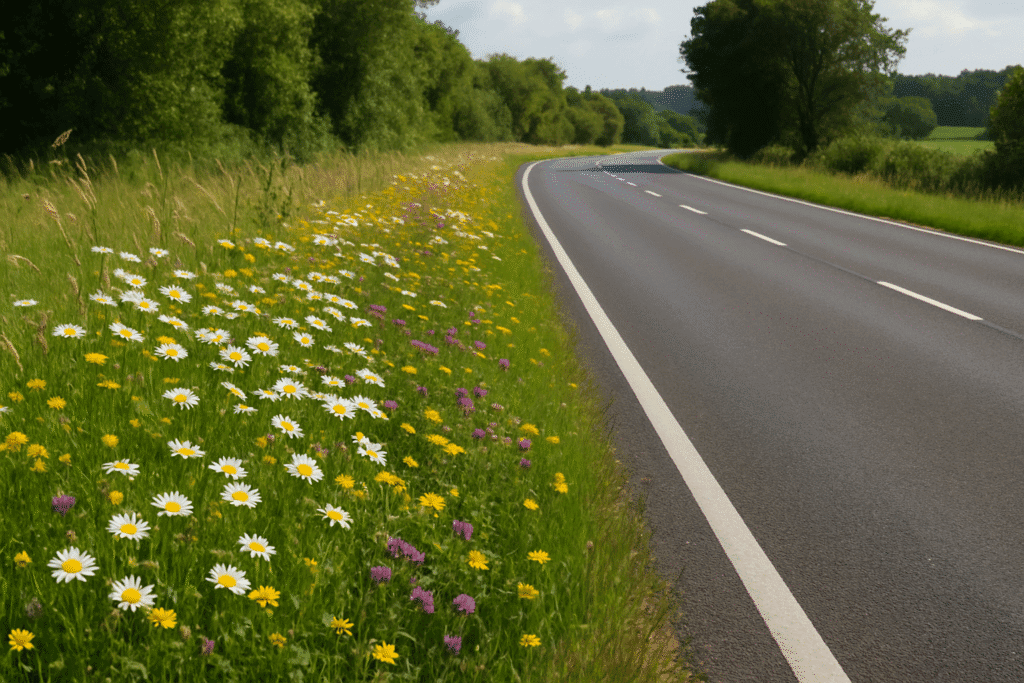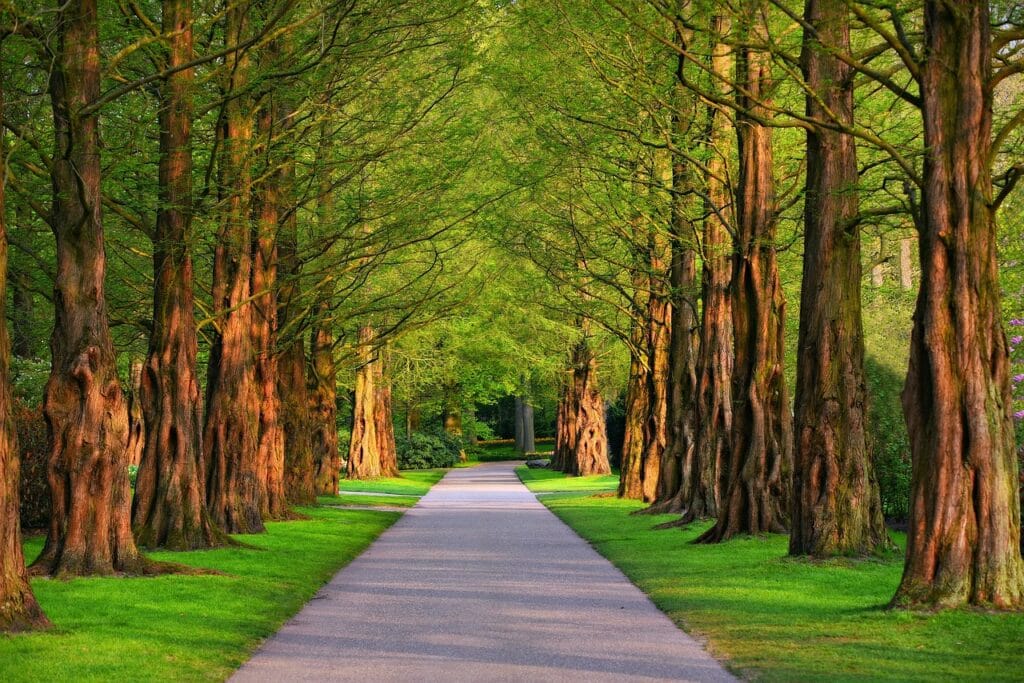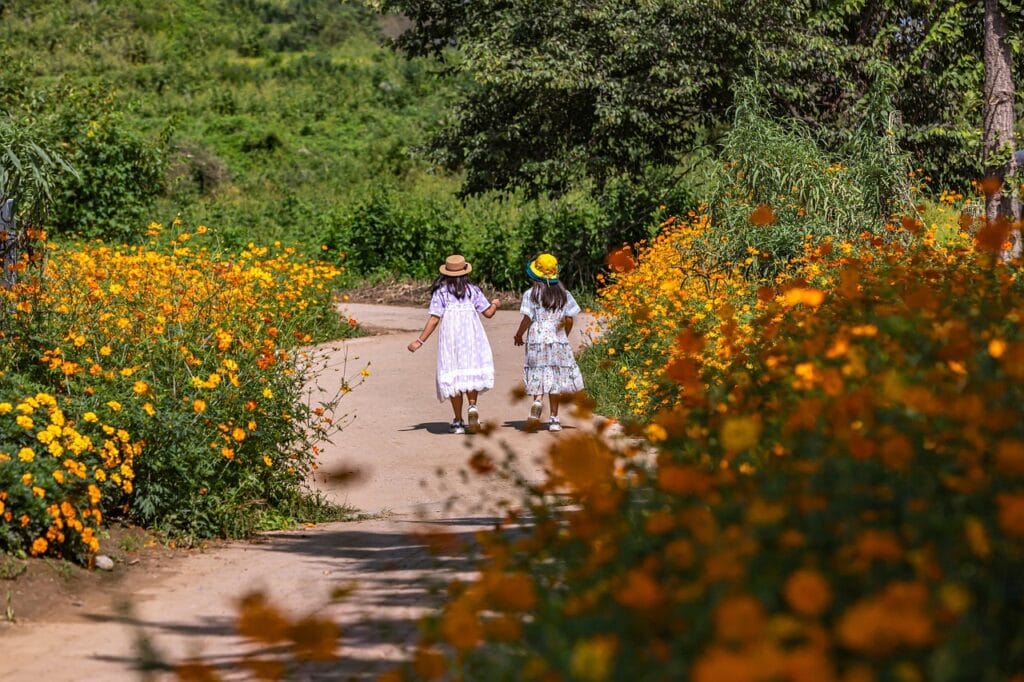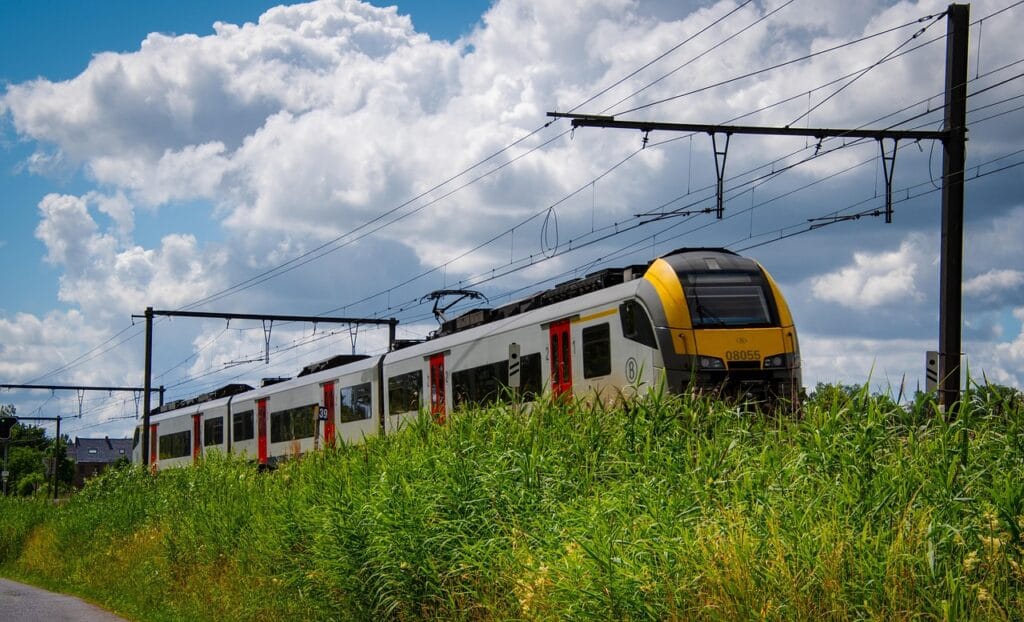
Table of Contents
ToggleIntroduction: deserving look for roadside vegetation
So beginning with the introduction, what are road verges ? They are the narrow strips of land you see next to roads, usually filled with dry grass, weeds or just left bare. Sadly, most of us don’t even notice them, but these small, ignored spaces can actually help to make our cities greener, healthier, and more aesthetically pleasing. In this blog, we will explore 10 powerful Benefits of road verges and discover what challenges they face, including their future insights.
In many parts of the world people are now recognising the importance and benefits of road verges. When the roads are planted with the right kind of vegetation like native grasses and wildflowers – they can become safe places for birds, bees, butterflies and other wildlife.
Benefits of road verges: how urban green verges create positive impact on biodiversity.
1. Shelter for urban pollinators all year round
Do you know that in crowded cities, natural habitats for bees, butterflies, and hoverflies are shrinking fast ? Urban road verges especially those which are planted with native wildflowers can become a perfect place where pollinators can find food rest and safe nesting site. Parks or balcony gardens are often busy and disturbed; on the other hand, watches are quieter and undisturbed.
Since roadside verges can run alongside roads, they can link together and form a small corridor that helps insects to travel across the city. Surprisingly even 1m wide urban green verges left unmown for a season cannot support dozens of insect species. UK’s biodiversity-focused verge management
2. Quiet green corridors that let wildlife move
Cities always break nature into fragments, I mean, one Park here, then another tree patch miles away. Seriously, for animals like hedgehogs, frogs, lizards or even birds this can feel like living on island with no bridges. But urban green verges can quietly connect these broken habitats.
A continuous verge along a street or railway can act like a mini wildlife highway that helps small creatures to move safely between food, shelter, and nesting spots. This movement is vital for species survival, especially in a warming climate where animals have to shift their territories. These narrow corridors look small but are very helpful to wildlife.
3. Free natural air purifier
Since vehicles release tiny particles that harm lungs and contribute to respiratory illness, Roads are considered a factory of pollution. Yet here are important benefits of road verges, they are planted with shrubs and dense native vegetation, and they can trap these particles before they spread in the air. Some plants can also absorb harmful gases like nitrogen dioxide. I know the effect is small but in busy cities every little bit matters. Well-vegetated areas not only look better than concrete, but they also filter the same air we breathe. Here is a great reference for discussing verges as purifiers
4. Local cooling that combats urban heat
Concrete and Asphalt absorb heat during the day and release it slowly at night, and this process makes cities warmer than the countryside – It is the phenomenon we call the urban heat island effect. When road verges are planted with vegetation they act as natural Coolants. Even short grasses and wild flowers cool down the lower surface temperature through shade and evaporation.
In residential areas this can reduce heat buildup near homes and footpaths. One of the benefits of roadside vegetation is that they don’t require electricity or heavy maintenance.

5. Natural stormwater sponges during heavy rains
Most urban roads are designed to send rainwater straight into drains but during heavy rainfall you have seen that most often the drainage system fails it leading to waterlogging, as well as floods. Green verges help to slow this down. Dear soil and plant roots absorb rainfall, which reduces water runoff and allows more water to seep into the ground naturally.
Some cities are even re-designing road edges with brain gardens and permeable verges to manage water more efficiently. So, in short, road verges connect like soft natural sponges during rainfall.
6. Natural buffer against traffic noise
Noise pollution is a daily struggle in urban life due to busy roads. While a verge can’t block sound like a solid wall, it can dampen noise if it is densely planted. Grasses, shrubs, and layered vegetation help to scatter sound waves and reduce echo from hard surfaces. This is mostly helpful near schools hospitals or residential streets.
Even if the change is subtle, the more natural cover on a verge, the more peaceful the surroundings feel. For many people, that’s the difference between a stressful walk and a pleasant one.
7. Low-cost carbon storage
Most often, urban planners overlook small spaces when they are thinking about climate solutions. These urban green verges store carbon in two ways – through the roots and leaves, and also in the soil itself. Unlike concrete, this living soil holds carbon for years, especially when it’s not disturbed by frequent mowing or digging. A single verge might store only a small amount, but if we scale it across the city, it can give noticeable benefits. It’s one of the simplest carbon offset tools we already have.
8. Visual relief and better mental health
Even tiny green spaces give relaxation to our minds. So what about a vegetated verge? It can turn A dull Street into something more will coming. For people walking, cycling, or simply waiting at the bus stop, this touch of greenery can reduce their stress, even if only for a moment. Research has shown that natural views reduce anxiety and improve focus, maybe you have experienced that. In fast-paced urban life, these micro moments of green relief are more powerful than we think.

9. A cheaper way to make green City
Creating new parks or green roofs is expensive and also time-consuming. Yet we forgot that Road verges already exist and they just need better planting. Converting these species into a native garden is far cheaper than building a new green infrastructure. Maintenance cost also decreases over time if mowing is reduced and perennial plants are used.
For cash-strapped cities, these verges offer a low-cost, high-return way to support nature without buying new land. In my opinion, it’s a smart move with an ecological impact.
10. A test ground for climate-resilient urban design
An underrated point from the benefits of Road verges, it offers a low-risk testing space for experimenting with native planting, soil retention techniques, drought-resistant species, and passive irrigation systems. Instead of trying risky projects in parks or public squares, cities can use these small strips as outdoor labs for future-proof green infrastructure.
Let me give you one example, Australia and Netherlands have tested wildflower strips, permeable soil beds and even smart irrigation sensors on road verges before scaling them in the city. This makes passive spaces and also active design tools in building climate-resilient cities.
Challenges and future possibilities

Challenges of road verges
Despite a lot of benefits of road verges, they often remain underutilized due to many financial, practical, and institutional challenges. Let’s raise some awareness:-
1. Maintain cost and responsibility confusion
Local municipalities and Road authorities often avoid green verges due to unclear maintenance roles. Many verges remain Barren or poorly maintained due to unclear policies on who will trim, water, or restore damaged vegetation.
2. Safety and visibility concerns
Dense vegetation near roads can create blind spots, hide signage, or interfere with drivers’ visibility, and that’s why urban planners often sacrifice green growth for safety purposes.
3. Lack of native plant use and design expertise
Many urban projects still rely on aesthetically pleasing non native plants that require more water and upkeep. Without ecological landscaping knowledge, verges become decorative rather than biodiverse.
4. Pressure from urban expansion
When cities start expanding, road verges are often narrowed, paved over or taken up by utility infrastructure like cables or drainage. They are treated as leftover land instead of valuable green space
- Future possibilities of road verges
Nowadays, cities are facing environmental problems, and they are compelled to build climate-resilient projects. Despite these barriers the future of road verges looks promising. Take a look :-
1. Designing with ecology
Landscape architects and planners are beginning to integrate pollinator-friendly native plants, permeable surfaces, and low-maintenance green corridors into verge design. This will make the road verges more functional and self-sustaining.
2. Data-driven urban Greening
GIS mapping and remote sensing are helping to identify high-priority zones where verges can best deliver ecosystem services. This could revolutionize the way to prioritize monitoring verge health.
3. Community stewardship models
In cities like Melbourne or Toronto, “adopt a verge” programs empower residents to maintain and plant native species. These grassroots models can be scaled globally through digital platforms and microgrants.
4. Nature-positive infrastructure Norms
The future of infrastructure may no longer be grey vs green. Instead we are moving toward hybrid Road system where biodiversity, carbon absorption and water management are built after every kilometre of road. How road verges fit into broader sustainable urban design.
Conclusion :-
Road verges are a very little discussed topic, people often ignore this. Most of us think that these small verges cannot create big impact, but we are wrong. There are lots of benefits of roadside vegetation. We discussed the 10 most powerful and important benefits of roadside vegetation across this article. There are some barriers, too, but when we come together, we can break these barriers easily. Every single effort is worth staying tuned.
You may also like :-
